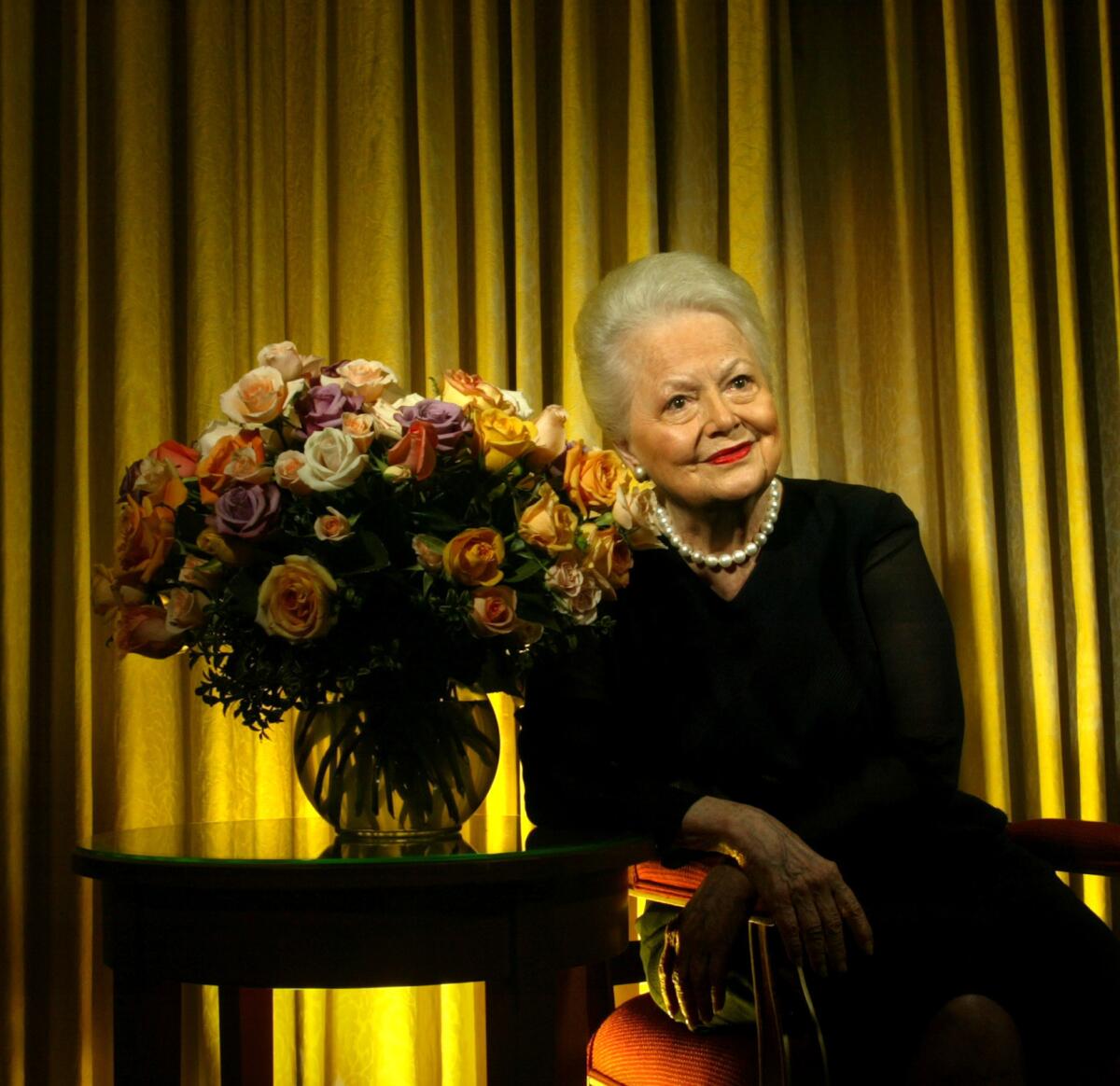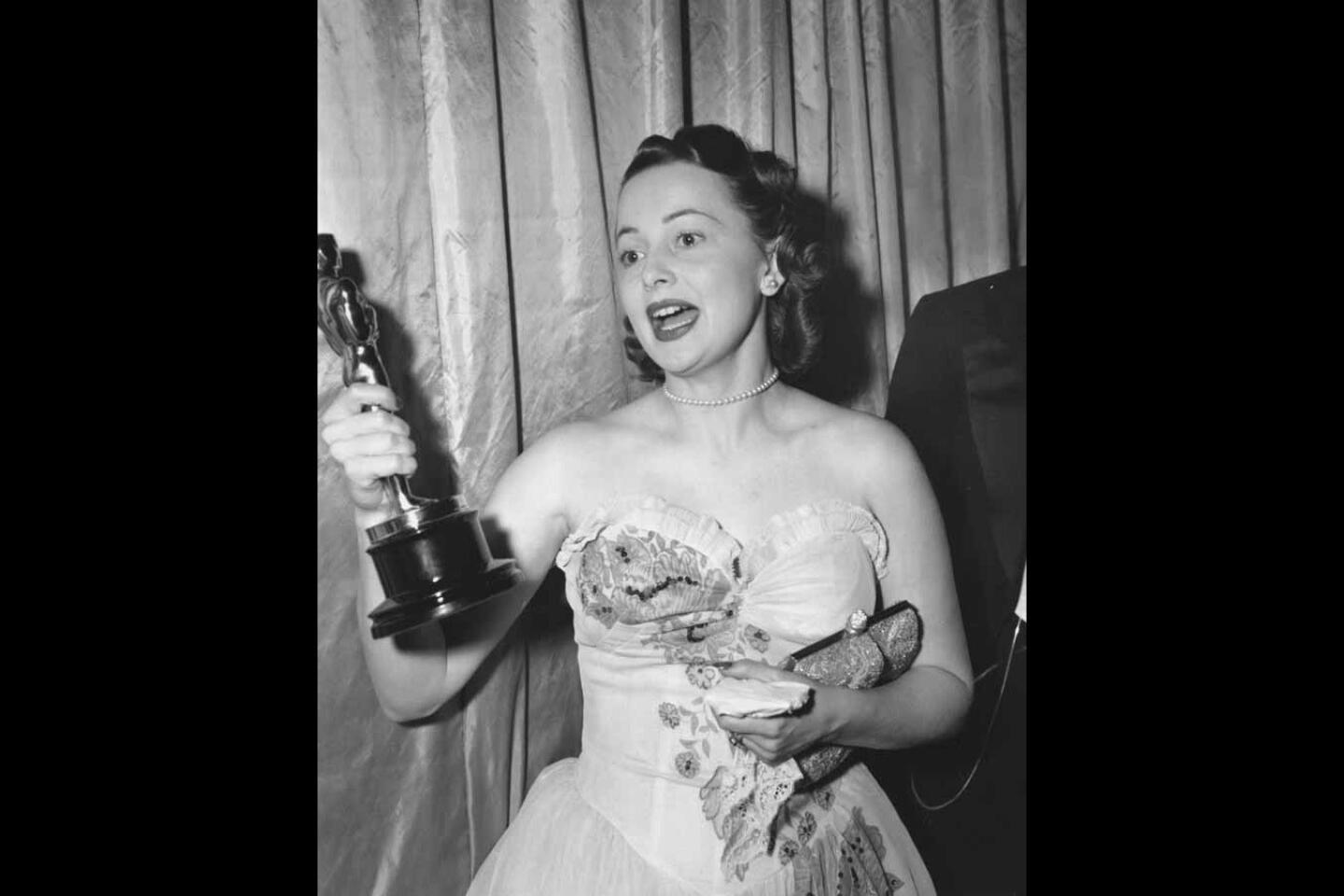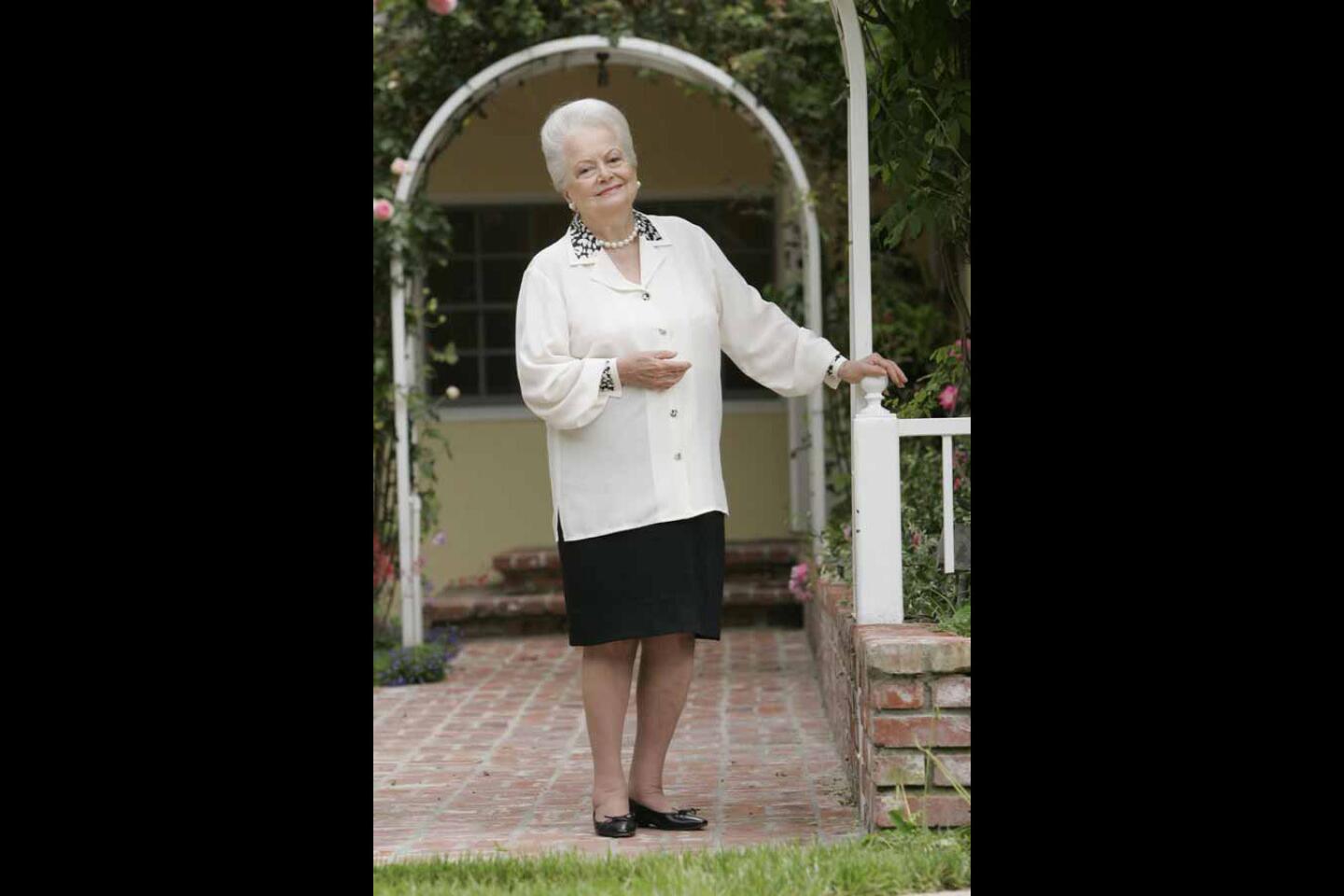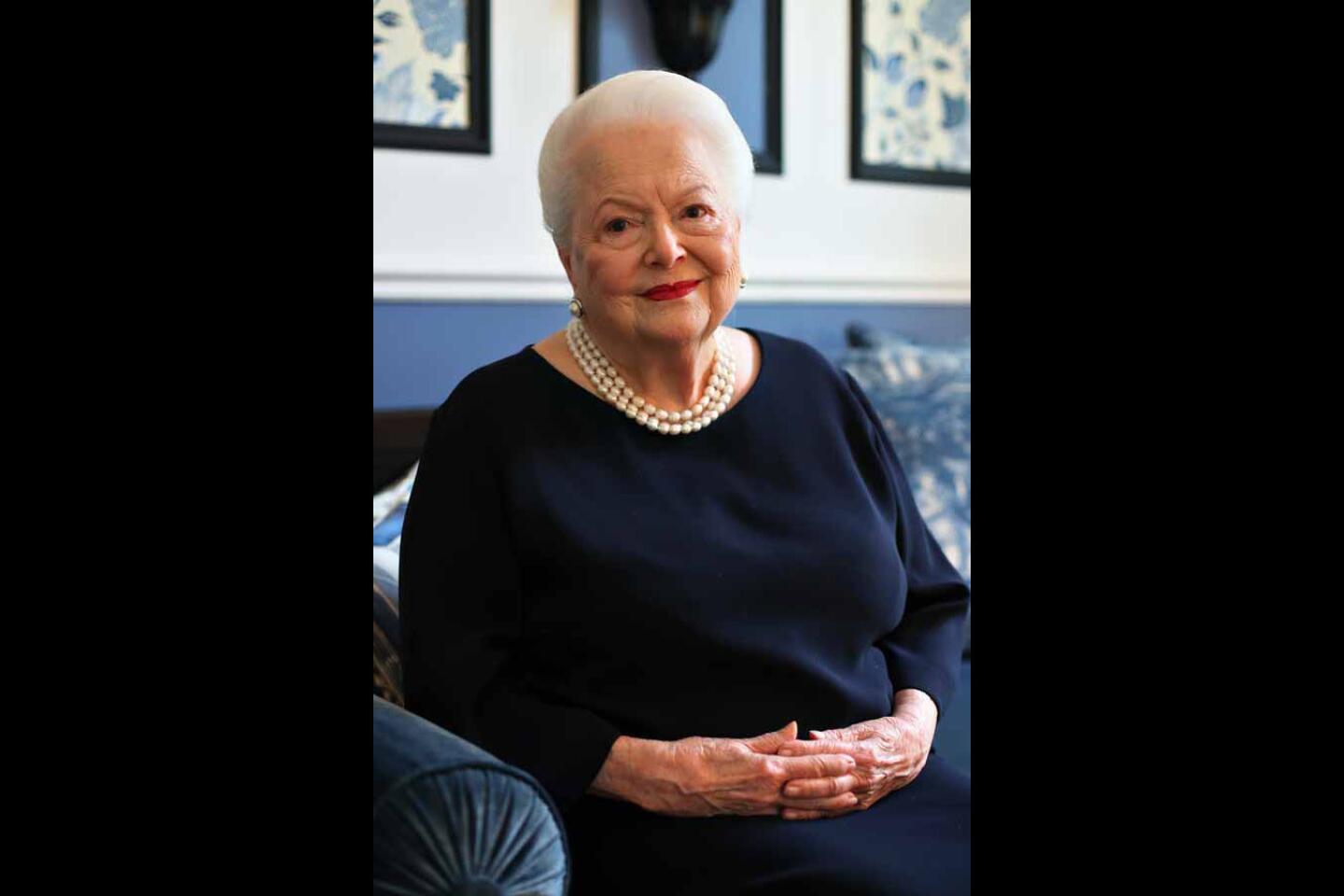Olivia de Havilland, last surviving star of ‘Gone With the Wind,’ dies at 104
- Share via
For the record:
1:43 p.m. Aug. 3, 2020This story incorrectly states that Olivia De Havilland was knighted by French President Nicolas Sarkozy. She was given the Legion of Honor by the French president.
Forever a free spirit in a buttoned-down world, Olivia de Havilland battled studios for workers’ rights, waged a 1st Amendment fight over the use of her image, and ultimately turned her back on the film industry and moved to Paris to live a life of unfettered freedom.
But through it all she remained the essence of Hollywood royalty, a title she gracefully accepted.
The last remaining star from the 1939 epic film “Gone With the Wind” and a two-time Academy Award winner, De Havilland died Sunday of natural causes at her home in Paris, where she had lived for decades. She was 104.
De Havilland was generally considered the last of the big-name actors from the golden age of Hollywood, an era when the studios hummed with activity and the stars seemed larger than life.
Though she lived in semi-retirement and could be spotted even late in life biking around her adopted hometown, the actress remained firmly in the public eye. In her final years she waged a 1st Amendment fight for privacy over the use of her image in the 2017 docudrama “Feud: Bette and Joan.”
On the eve of her 101st birthday she sued FX over what she alleged was the unauthorized use of her identity in the miniseries, which chronicled the storied rivalry between actresses Bette Davis and Joan Crawford. Catherine Zeta-Jones portrayed De Havilland in the serial.
“I was furious. I certainly expected that I would be consulted about the text. I never imagined that anyone would misrepresent me,” she told The Times in 2018, adding that the series characterized her as a “vulgar gossip” and a “hypocrite.”
The case was expedited due to De Havilland’s advanced age. Despite early victories, the U.S. Supreme Court declined to hear the case in early 2019.
Earlier in her career, movie audiences knew De Havilland best as the demure, pretty heroine opposite the dashing Errol Flynn in “Captain Blood” and other popular Warner Bros. costume dramas of the 1930s, including “The Adventures of Robin Hood” and “The Charge of the Light Brigade.”
But she won her lead-actress Oscars in more substantial, less flattering roles after leaving Warner Bros. in the mid-1940s.
Her first Oscar came for the 1946 film “To Each His Own,” a World War I-era drama in which she plays an unwed mother who lives to regret giving up her young son.
She won her second for “The Heiress,” a 1949 drama set in 19th century New York in which she portrays a shy and plain-looking young woman who falls in love with a handsome young man (played by Montgomery Clift) whom her wealthy and overbearing father suspects is a fortune hunter.
De Havilland also received a lead-actress Oscar nomination for her memorable role in “The Snake Pit,” a 1948 drama that chronicles the mental breakdown and recovery of a young married woman who is placed in a mental institution.
But her most enduring screen role was that of sweet Melanie in “Gone With the Wind,” the Civil War drama that won hearts and Oscars but ultimately became a symbol of the country’s systemic racism for its romanticized portrayal of the antebellum South and its sanitized treatment of the crushing horrors of slavery.
WarnerMedia pulled the film from its streaming service during the national protests sparked by the May 25 death of George Floyd after a white Minneapolis police officer pinned him to the ground by leaning on his neck for several minutes as other police officers appeared to look on dispassionately.
De Havilland was the last survivor among the film’s principal actors, who included Clark Gable, Vivien Leigh, Leslie Howard and Hattie McDaniel.
Off-screen, De Havilland was known in Hollywood for her milestone legal victory over Warner Bros. in the mid-1940s, a court decision that revolutionized actor-studio contractual relationships and later provided ammunition for her battle with FX.
And industry insiders and fans were well aware of her much-publicized feud with her movie-star sister, Joan Fontaine, an outsized sibling rivalry that began in their childhood.
“My sister is one year, three months, three weeks and one day younger than me,” De Havilland told the Washington Post in 1979 when she was 62. “When one does everything first, it must be very hard on the second. I find it a great pity.”
In her autobiography, “No Bed of Roses,” Fontaine speculated that De Havilland would have preferred to be an only child and always resented having a younger sister.
That Fontaine followed her sister to Hollywood and won the first lead-actress Oscar in the family — in 1942 for “Suspicion,” beating out De Havilland in “Hold Back the Dawn” — didn’t help matters.
In a 1978 interview, Fontaine said, “I married first, won the Oscar before Olivia did, and if I die first, she’ll undoubtedly be livid because I beat her to it.”
Fontaine died of natural causes in 2013 at the age of 96. De Havilland said the two had mended their differences before her sister’s death.
The daughter of British parents, De Havilland was born July 1, 1916, in Tokyo, where her father headed a patent law firm. Her mother, who had attended the Royal Academy of Dramatic Arts in London, named her first-born daughter Olivia after the character in Shakespeare’s “Twelfth Night.”
In 1919, when De Havilland was not yet 3, her parents’ marital problems prompted her mother to take her two daughters and move to Northern California, where they settled in Saratoga, near San Jose. De Havilland’s parents later divorced, and her mother married George M. Fontaine, manager of a local department store.
At Los Gatos Union High School, De Havilland joined the drama club and, despite a tendency to suffer stage fright, appeared in school plays and won trophies on the debating team and in a public speaking contest.
After high school graduation in 1934, she earned a scholarship to attend Mills College in Oakland, but her life took a detour that summer.
An assistant for renowned director Max Reinhardt saw the Saratoga Community Players’ production of Shakespeare’s “A Midsummer Night’s Dream,” in which De Havilland played Puck.
Reinhardt was assembling a national touring production of that play to debut at the Hollywood Bowl, and De Havilland was invited to join a group of other students to observe rehearsals in Hollywood.
She wound up as an understudy, and when actress Gloria Stuart had to drop out of the Hollywood Bowl production, which included Mickey Rooney as Puck, De Havilland took over the role of Hermia.
In the audience on opening night was Warner Bros. production executive Hal Wallis, who was so impressed with De Havilland’s performance that he implored studio boss Jack Warner to see the show.
Warner agreed with Wallis’ assessment that the 18-year-old would be perfect for the studio’s upcoming movie version of the Shakespeare fantasy and that she had the makings of a star.
After completing the four-week national tour, De Havilland signed a seven-year contract with Warner Bros.
By the end of 1935, her first year at the studio, she had not only played Hermia, but also played opposite Joe E. Brown in “Alibi Ike,” appeared with James Cagney in “The Irish in Us” and costarred with Flynn, another new Warner contract player, in “Captain Blood.”
Flynn and De Havilland appeared together in seven more films over the next six years, including “Dodge City,” “The Private Lives of Elizabeth and Essex” and “They Died With Their Boots On.”
But the fiercely ambitious De Havilland yearned to play more challenging roles than those being offered to her at Warner Bros.
“I believed in following Bette Davis’ example,” De Havilland told The Times in 1988. “She didn’t care whether she looked good or bad. She just wanted to play complex, interesting, fascinating parts, a variety of human experience.”
She found such a role in “Gone With the Wind,” independent producer David O. Selznick’s sweeping adaptation of Margaret Mitchell’s Pulitzer Prize-winning novel about the Civil War and Reconstruction.
The question of who would play Scarlett O’Hara had become a national fixation, and one of the actresses who was interested was De Havilland’s sister, Joan.
In “Sisters,” Charles Higham’s dual biography of De Havilland and Fontaine, “Gone With the Wind” director George Cukor is quoted as saying that Fontaine asked to read for the part of the fiery Scarlett. Cukor told the blond actress that that was out of the question, but he would like her to read for the role of the more sedate Melanie.
“If it’s a Melanie you want,” Fontaine reportedly snapped, “call Olivia!”
Cukor did. And after De Havilland performed a scene at Selznick’s home, with Cukor playing opposite her as Scarlett, Selznick looked at De Havilland and declared, “You’re Melanie!”
“Gone With the Wind” was nominated for 13 Academy Awards, including lead actress for Leigh as Scarlett and supporting actress for performances by De Havilland and McDaniel.
Although she was one of the film’s four lead players, De Havilland once said, “In those days, regardless of billing or contract, the producer had the right to decide the category; and Selznick, in order not to split the vote between Vivien and me, put me down as supporting actress.”
On Oscar night, Leigh won as lead actress and McDaniel walked away with the supporting actress honor, the first Black American to receive an Academy Award.
Still unhappy with the kinds of roles Warner Bros. was offering her, De Havilland took frequent suspensions for refusing them.
In 1943, her seven-year contract with Warner Bros. had run its course. But because she had been placed on suspension numerous times for refusing roles, the studio maintained that she owed it an additional six months.
De Havilland hired well-known Hollywood attorney Martin Gang, who informed her that state labor laws said that a seven-year contract was for seven calendar years only. She took Warner Bros. to court.
De Havilland won her case in Superior Court, but Jack Warner appealed the decision and enjoined other film companies from hiring her. When the Appellate Court voted unanimously in De Havilland’s favor, Warner appealed to the state Supreme Court. In February 1945, that court upheld the decision.
Since then, the judgment has been known as the De Havilland Decision. Decades later, De Havilland’s legal precedent helped musician and Oscar winner Jared Leto persuade the courts to apply the rule to recording contracts as well.
Freed from Warner Bros., De Havilland began freelancing at different studios and had her choice of scripts.
The actress, whose name had been romantically linked with Howard Hughes, James Stewart and John Huston, among others, married writer Marcus Aurelius Goodrich, author of the bestseller “Delilah,” in 1946. They had a son, Benjamin, and were divorced in 1952.
A year later, De Havilland met Pierre Galante, a writer and executive of Paris Match magazine. She and Galante married in Paris in 1955 and had a daughter, Gisele. They were divorced in 1979.
She appeared on Broadway several times during the ‘50s and ‘60s, including a 1951 revival of “Romeo and Juliet,” a 1952 revival of “Candida” and “A Gift of Time” in 1962 with Henry Fonda.
But she appeared in only nine films in the ’50s and ’60s, including “Lady in a Cage” in 1964 and “Hush ... Hush, Sweet Charlotte” opposite her old Warner Bros. colleague Bette Davis the same year.
In her later years, she appeared in movies such as “Airport 77” and “The Swarm” in 1978. She also did occasional work on television, including “Roots: The Next Generations” in 1979 and, most notably, in 1986 as the Dowager Empress in a four-hour presentation of “Anastasia,” for which she earned an Emmy nomination for supporting actress. She officially retired in 1988.

In 2003, De Havilland returned to Los Angeles and was a presenter at the 75th Academy Awards. Five years later, President George W. Bush presented her with the National Medal of Arts and — two years after that — she was knighted by French President Nicolas Sarkozy. In 2018, she was made a dame of the British Empire, becoming the eldest living person to receive the honor.
De Havilland is survived by her daughter, Gisele. Her son, Benjamin Goodrich, died of complications of Hodgkin’s disease in 1991.
Times staff writers Nardine Saad and Steve Marble contributed to this report. McLellan is a former Times staff writer.
More to Read
Start your day right
Sign up for Essential California for the L.A. Times biggest news, features and recommendations in your inbox six days a week.
You may occasionally receive promotional content from the Los Angeles Times.









